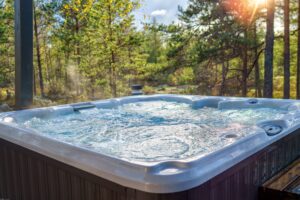by Paige Jessup, Climate Resilience Intern
Improperly draining your hot tub or pool can not only result in large fines but can also potentially result in the wastewater ending up in local freshwater bodies and making them inhabitable for some freshwater species. Most municipalities have guidelines for disposing pool or hot tub water, which can also be defined as “wastewater” or “greywater”. It is important to check with your municipality bylaws, provincial building codes, or your public health unit to verify the regulations in your area for the safest way to dispose of your pool or hot tub water before emptying.
The following are some general guidelines for disposing of your pool or hot tub water:
- Remove leaves and other debris before discharging the water.
- Dechlorinate the water before draining it.
- Use test kits to make sure chemical levels are as close to zero as possible before draining.
- Drain water into a laundry tub (if it is connected to a city sanitary sewer system).
- Maintain proper pH.
- Be sure to report any spills to your local authorities if it goes into a lake, river, or storm sewer system.
- If draining the water is not possible, have the water hauled by a ministry approved company.
- Never drain the water from your hot tub directly into a lake, wetland, pond, or reservoir
- Do not drain your hot tub water directly into the street or storm sewer/drain. This water will not receive any treatment and often makes its way to a local water body where it can be harmful to aquatic life.
- Do not add any chemicals to your hot tub one to two weeks before you plan on draining it, and make sure to leave the cover off to allow the chemicals to evaporate. If needed, you can use a dechlorination tablet in the hot tub water and let it sit for at least one week to help get rid of the chlorine. Run your heater and jets periodically if you have them to help speed up the process.
- Do not drain on a rainy day or just before a storm is forecasted.
Chlorine Pools and Hot Tubs
Algae are known to be sensitive to chlorine. When chlorine enters an aquatic environment, it causes the lakes to become enriched with nutrients which cause harmful algal blooms and starve the lake of oxygen. This has devastating impacts on the fish, vegetation, and wildlife. When draining a pool or hot tub with chlorine based cleaners, it is important to keep in mind best practices. For example, once the chemicals have been removed, you may choose to drain the water onto your lawn or garden where it can be absorbed and filtered. Do this slowly in small batches over a few days so the water has time to soak into the ground. Make sure the water stays on your property and does not go toward your house, or onto your neighbor’s property, the road, in a storm sewer, or near a water body. If it is raining or the ground is already wet, wait until it dries up. The water will not absorb into the ground if it is already wet.
Another option, if you are connected to a city sanitary sewer system, is to drain the water into a laundry sink or another drain that is connected to this system. This will allow the water to be treated. If you are on a septic system, do this slowly over a few days so as to not overwhelm your system.

Saltwater
Increased salinity can make freshwater ecosystems uninhabitable and cause disruptions in vulnerable life stages for aquatic species such as amphibians, fish, and aquatic insects. It is often advised to not drain water from a saltwater pool or hot tub onto your lawn as the salt levels can kill your grass. One option is to have this water hauled away by a Ministry of the Environment and Climate Change-approved hauler. Another option is to discharge the water into the sanitary sewer system using a connection such as a laundry sink or floor drain. It is best to do this during non-peak times.
Other Considerations
Another safe option is to contact someone that has experience handling these types of chemicals, such as disposing of the water at a household hazardous waste (HHW) facility or contacting the local Solid Waste Authority. It is important to do your due diligence and look into your local municipality guidelines for disposing of wastewater no matter which option you choose. This will ensure your disposal is safe and will not end up polluting the local water bodies.
Take the next step! Watersheds Canada is initiating an education awareness campaign to protect our freshwater ecosystems from hot tub and pool pollution. Your action could be the ripple effect needed to spark change. Share this education campaign with those in your network and community as we all join hands against pollution to our freshwater areas.
References
Alexander, B. (2016). Got a hot tub? Here’s how to safely (and legally) drain it. Cottage Life. Retrieved from: https://cottagelife.com/design-diy/got-a-hot-tub-heres-how-to-safely-and-legally-drain-it/
MLI Environmental. (n.d.) How to Properly Dispose of Pool Chemicals. MLI Environmental. Retrieved from https://mlienvironmental.com/blog/how-to-properly-dispose-of-pool-chemicals/
Yan, Z., Wang, Y., Wu, D., & Xia, B. (2018). Exploration of an urban lake management model to simulate chlorine interference based on the ecological relationships among aquatic species. Scientific Reports (Nature”Publisher Group), 8, 1-14. doi:https://doi.org/10.1038/s41598-018-26634-8
This blog is part of an education toolkit generously funded by:

